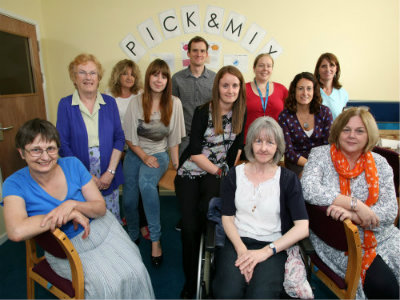
The distinctiveness of Shropshire social work practice People2People strikes you as soon as you enter its offices, on an out-of-town shopping park in Shrewsbury.
There are no security officers and no requirements to have an appointment or to sign in for a visitor’s pass. People seeking social care support can wonder in, perhaps after doing their shopping at the neighbouring supermarket, and are most likely to be met with an offer of a cup of tea rather than a request to justify their presence. They might even happen upon the team in one of their regular meetings over biscuits around the round table that sits in full view to the outside behind the front door.
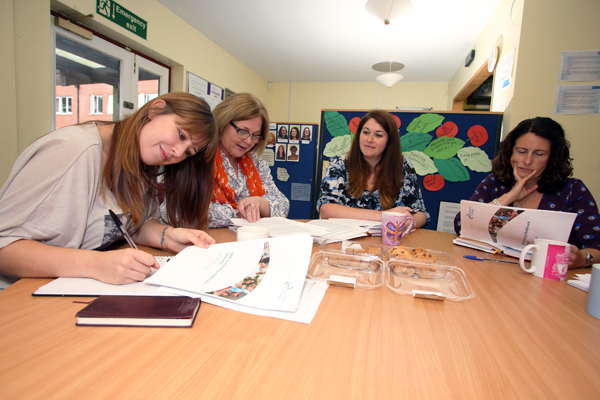
Social workers (from left) Emma Speedy, Ros Adams, Laura Cross and Sue Bunker (Credit: Neil O’Connor)
The social enterprise, formed by staff seconded from Shropshire council, took this rather cramped office, rather than the cheaper option of a spot within the council offices, quite deliberately. The message is that real or perceived barriers between social workers and service users (a term not used by People2People staff), between professionals and the community, between managers and staff or between people eligible or not eligible for statutory support don’t apply.
People2People, formed in January 2012, is one of seven Department of Health pilots designed to test the contracting out of statutory adult social work from councils to independent organisations. The original team provide assessment and short-term support in Shrewsbury, taking most incoming referrals within the city. However, People2People has recently expanded to take responsibility for council teams providing short- and long-term support in the south east and south west of the county, while some newer members of staff in Shrewsbury are now directly employed by the practice, rather than seconded from the authority.
Its funding comes from the council in the shape of operating costs – including seconded staff members’ salaries – and delegated authority to allocate community care funds on its behalf through personal budgets.
Controversy
Social work practices are controversial: for critics they represent a staging post to the full privatisation of social work and an opportunity to drive down staff terms and conditions by removing the benefits of having a statutory employer. But for their proponents they provide an opportunity for social workers to have a much greater say in their practice, work creatively, engage in community development and not just individual case work, and truly involve people who receive support in the running of services. As with Topaz, the social work practice in south London we reported on last year, this message also comes through loud and clear from People2People’s staff.
Professional practice lead Ros Adams admits she was wary of moving from her post as a senior social worker at the council when People2People was first mooted. “It’s a scary thing, I can’t deny that; there’s a certain amount of bravery in signing up to it. We’ve all had moments in which we’ve thought ‘oh my god’.”
Senior social worker and original People2People staff member Sue Bunker adds. “A lot of colleagues said we shouldn’t do it because it was the beginning of privatisation,” she says. “But I decided I’d rather be involved in something at the start and shape it; and I’m so glad that I did.”
This positivity was reflected in the other staff I met and derives from several factors. One is the clear sense of ownership staff feel in the running of the organisation.
Staff ownership and collective decision-making
Part of this is formal: there is one slot for staff on the board that governs People2People, which is currently occupied by Adams, who was put forward by her colleagues. Staff can also attend and feed into board meetings. But though Adams manages the other six practitioners in the Shrewsbury team, practice decision-making appears to be truly collective and without hierarchy.
“We’ll sit round the table and stick things on the flipchat and by the end we’ve come up with a solution,” says Adams. “People say ‘can I run this past you?’ to each other. If someone finds [a new source of support] in the community they come back and share that with the team.”
Newly qualified social worker Emma Speedy, who did a statutory practice placement in another team before joining People2People, says: “The biggest difference is that people have a genuine interest in your cases. In the previous team, if you talked to people it felt very time-restricted or you had to do it in supervision.”
Another critical factor is that the People2People team extends beyond people who have a qualification in social work or a paid career behind them in social care.
Beyond ‘service user involvement’
Many of the carer’s assessments delivered by People2People are carried out by Maureen Bradley, a local resident who is also a carer for her husband and son. She also has one of four people currently sitting on People2People’s governing board. Many people who need help with support planning receive this from Mary Hastings, who uses services herself. She also chairs the advisory board of people who use services, carers, volunteers and community representatives that informs the running of the organisation and votes one member on to the board, in this case Bradley.
The benefits are felt on all sides. “I’m amazed as to how empowered I’ve been to do this,” says Hastings, who started receiving support over five years ago following an accident. “I have very little vision or hearing. I didn’t expect I’d be able to work or do something meaningful.”
“[The peer supporters] provide a different perspective on support,” says newly-qualified social worker Laura Cross. “Quite often I will come away amazed by how well [the peer supporters] have supported another person; the person would have walked into the room quite shy and sheepish and left a totally different person [after receiving peer support].”
Bradley often runs group sessions with carers in which she supports them to fill out their assessment forms while also encouraging them to share experiences and ideas for support. “People learn from each other,” she says. “If you’ve been there and walked the walk you can often pass that on.”
Creative thinking and unfunded support
The team ethic and involvement of people with experience of support helps foster a creative approach to working with people that places as much emphasis on unfunded as funded support. In its first year People2People carried out 874 assessments, including 312 for carers; of these just 119 people received a short-term personal budget while 67 went on to receive a personal budget on an ongoing basis. Other people found different ways to meet their needs.
The team speak passionately about shifting from a mindset that sees eligible unmet needs as requiring paid support towards one that looks for solutions in people’s own resources and those of their community, saying this is more empowering for people.
“To begin with when I received a referral I’d almost pre-empt what [care] should go in,” says Speedy. “But now go in with the mindset of letting them tell you their story and afterwards discussing what support they might need.”
She cites a referral she received concerning a woman who had not received services before going into respite care after she began neglecting herself. The family favoured residential care but Speedy persuaded them that she could manage back at home, with some home care.
“I had a phone call from her daughter the other day who said [her mother] was doing really well and didn’t need the carers. She was showering herself again and going out driving,” says Speedy. “When I first met her she was really down and not doing a lot.”
So what made the difference? “She had the encouragement of someone saying ‘you can do this’. Often people don’t get that.”
Making this approach work requires a strong awareness of available community resources that people can draw on, but also setting high expectations for people seeking support to take responsibility for improving their lives. This is something Hastings promotes in her peer support work.
She recounts a recent peer support session with two people where she asked both to work on a profile of themselves before the next session. One person came back having done some of the work and the other having done nothing.
“There was a realisation then that the service wasn’t going to do it for them,” she says. “We’ve given them some support, now it’s in their hands. It was a really important lesson for the two people.” By contrast, on another occasion, she gave another person who came in for peer support some useful contacts and he went away and set things up for himself.
“For me that was more satisfying,” she says. “The effort I had put into researching thing for him had been for a purpose. From coming in with needs, some of which had been quite critical, he went away so motivated.”
Adams says this approach is not about cutting support for people who need it but fostering independence and personalisation. “When we first started to look at the figures and saw that we’ve done so many assessments and put in place so many packages of funded care I thought ‘are we doing this wrong?'” But then she looked at re-referral rates, to check whether people were going away with inadequate levels of support, and found these were very low.
Critical friends at the council
People2People’s ability to implement its way of working has been critically dependent on the support of Shropshire council, particularly of transformation lead officer Sarah Dillon and director of adult services Stephen Chandler.
Over time, the council has provided People2People with greater and greater freedom over its delegated budget; for example, now Adams can sign off ongoing personal budgets for a year up to a certain sum, up from six weeks.
Dillon says the council monitors People2People’s performance against national indicators in the Adult Social Care Outcomes Framework (ASCOF), as it does other in-house social work teams. However, the social work practice also faces specific targets around fostering peer support and people’s ability to access community resources.
“They are achieving the ASCOF targets as a minimum and all the additional stuff has been favourable.” Dillon, who declares herself a “critical friend” of People2People, says its distance from the council has made it easier for the practice to forge better links with community groups, while the central involvement of people receiving support has been vital to its success.
“When you are sitting around the table with service users who are reporting to the board of the company and they are telling you directly how they see things, it gives you a reality check,” she says.
The future for People2People
The expansion of People2People into the south of the county has been well-received by staff there, says social worker Jenny Cammies from the south east team. She is already feeling a greater say over her working practices: “I think we are being given more opportunity to say if we think something’s not working and are having more meetings with our seniors.”
The social work practice pilots cease in March 2014. Before then Shropshire council have decided whether People2People will continue or whether the services it provides will be taken back in-house.
Some difficult issues will need to be resolved before that decision is made. For example, the government will need to make clear whether staff currently seconded from councils to social work practices can be fully transferred to those organisations while retaining membership of the local government pension scheme. Also, People2People – were it to continue as a going concern – would need to consider how it could afford to provide a pension to staff that it employs directly and any new staff who join subsequently.
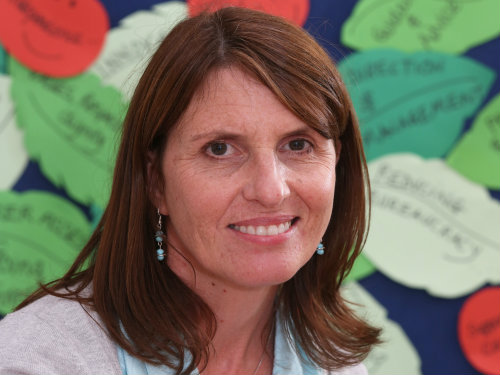
Managing director Jenny Pitts (Credit: Neil O’Connor)
“We want to be a good employer,” says recently-appointed managing director Jenny Pitts, a social care consultant who helped set up People2People and was previously a non-executive director. “But offering an attractive pension is inevitably going to cost us as an organisation. But that decision is not going to be taken in a closed room; it’s for staff to decide collectively.”
Whatever the risks for staff, Pitts is clear that being outside the council has been critical to making the People2People model work. “The team needed to extricate itself from the council to do what it has done,” she says. “There’s no reason why it shouldn’t be possible to work in a person-centred way within a council but it tends to get swallowed up by bureaucracy.”
Related articles
Life beyond the council: meet the social work pioneers
Social enterprise takes charge of statutory social work
Social work practice pilot dropped because of service restructure

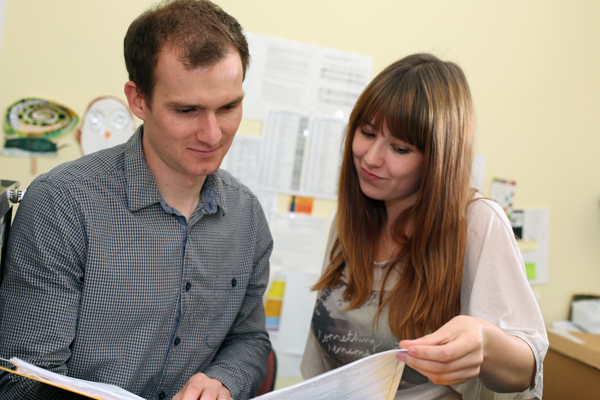
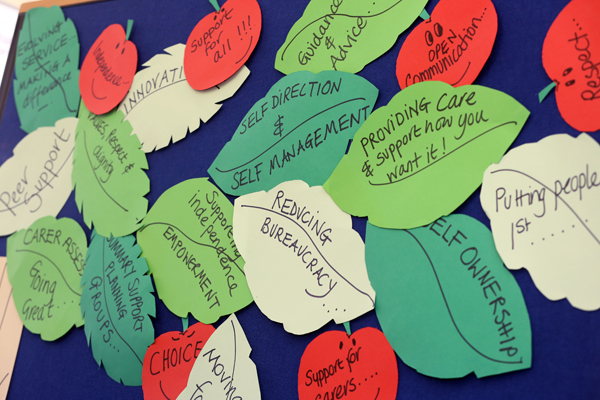

 Assistive technology and dementia: practice tips
Assistive technology and dementia: practice tips  A trauma-informed approach to social work: practice tips
A trauma-informed approach to social work: practice tips 




 Find out how to develop your emotional resilience with our free downloadable guide
Find out how to develop your emotional resilience with our free downloadable guide  Develop your social work career with Community Care’s Careers and Training Guide
Develop your social work career with Community Care’s Careers and Training Guide  ‘Dear Sajid Javid: please end the inappropriate detention of autistic people and those with learning disabilities’
‘Dear Sajid Javid: please end the inappropriate detention of autistic people and those with learning disabilities’ Ofsted calls for power to scrutinise children’s home groups
Ofsted calls for power to scrutinise children’s home groups Seven in eight commissioners paying below ‘minimum rate for home care’
Seven in eight commissioners paying below ‘minimum rate for home care’
 Facebook
Facebook X
X LinkedIn
LinkedIn Instagram
Instagram
Comments are closed.